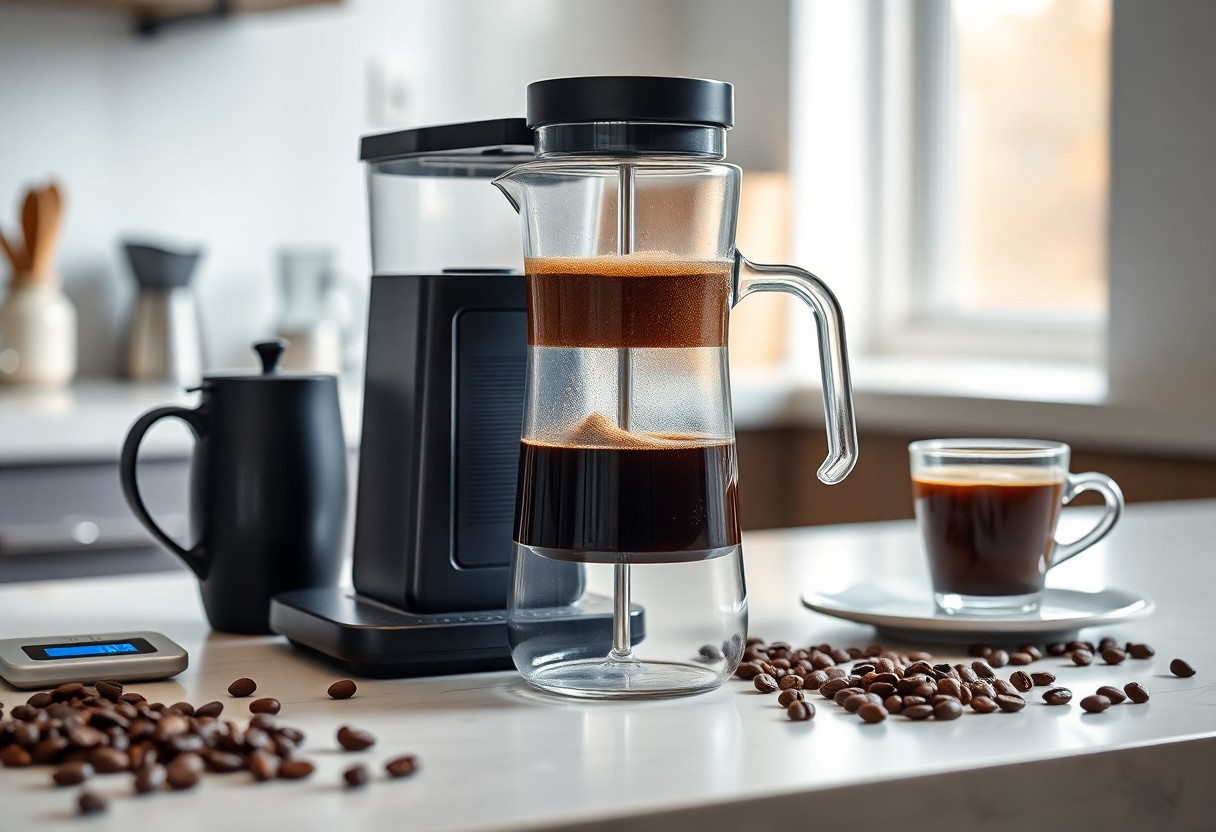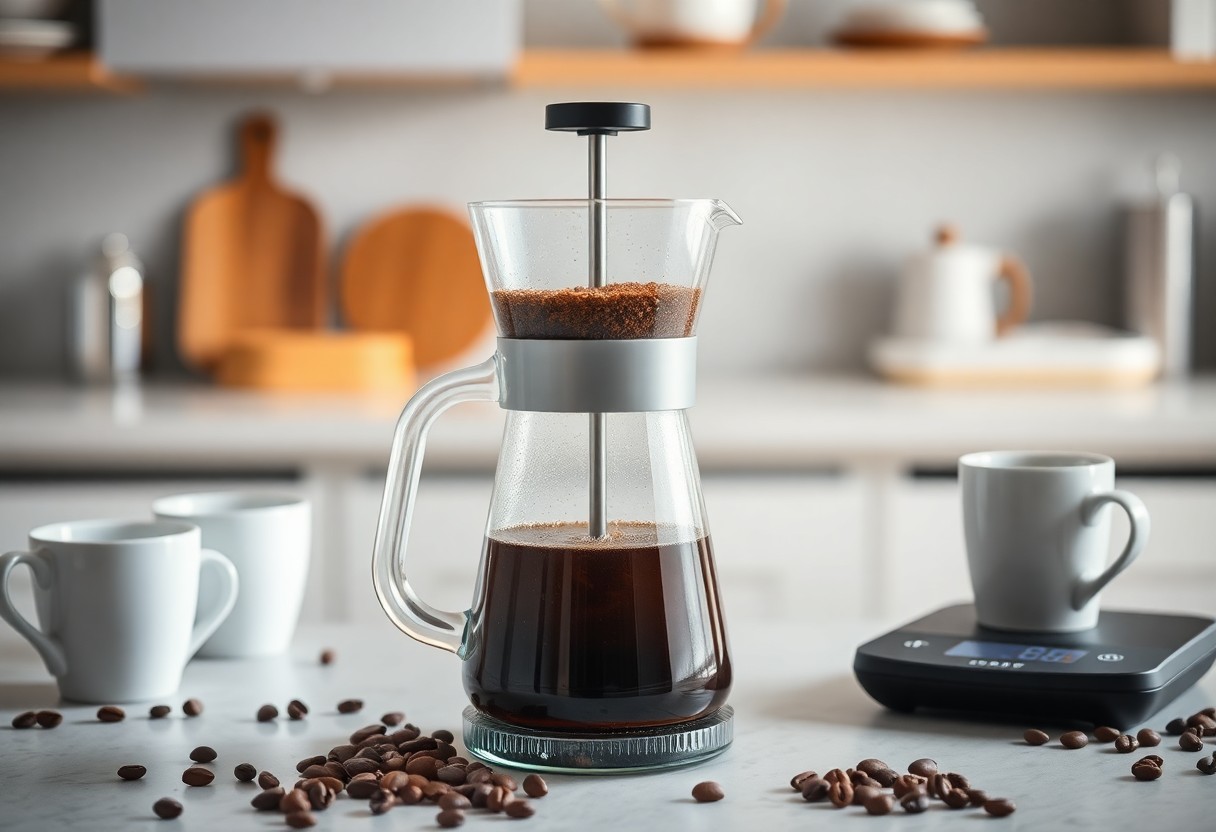Many coffee enthusiasts are pleasantly surprised when they explore the art of reverse brewing, a method that begins with cold water to create a uniquely mellow cup. By altering the traditional brewing process, you can extract nuanced flavors and aromas that are often overshadowed in typical hot brews. This innovative approach not only enhances your coffee experience but also minimizes bitterness, allowing for a smooth and enjoyable sip. In this post, you will discover the step-by-step process to achieve the perfect brew and the science behind it.
Key Takeaways:
- Using cold water at the beginning of the brewing process leads to a smoother and more mellow flavor profile in the final cup of coffee.
- This technique allows for a more gradual extraction of flavors, reducing bitterness and enhancing the subtler notes in the coffee beans.
- Reverse brewing can be adapted to various brewing methods, inviting experimentation and personalization for coffee enthusiasts.

The Science of Cold Brewing: Chemistry in Your Cup
Understanding the chemistry behind cold brewing provides insights into why this method enhances flavor profiles. By using lower temperatures, you’ll promote a unique extraction process that favors smoother, sweeter notes while minimizing the bitterness that often comes from hot water brewing methods. This gradual extraction allows the nuanced flavors of the coffee to bloom, creating a cup that is exceptionally palatable, especially for those seeking a mellow experience.
The Role of Temperature in Extraction
| Hot Water | Extracts oils and acids quickly, leading to higher bitterness and acidity. |
| Cold Water | Extracts flavors more slowly, which enhances sweetness and reduces sharpness. |
Flavor Profiles: How Cold Water Changes Taste
The use of cold water in brewing alters the flavor profile significantly. While hot water can extract a range of compounds including acids and oils that contribute to bitterness, cold brewing minimizes these elements. As a result, you’ll discover a coffee that reveals its sweeter, fruity undertones, alongside a velvety smooth mouthfeel.
In a cold brew, the extraction of volatile compounds is highly selective, emphasizing the natural sugars present in the coffee beans. You benefit from a delightful balance that highlights *chocolatey* and *nutty* flavors, while avoiding harsher notes. Additionally, this brewing technique encourages *low acidity*, making the coffee easier on your digestive system and perfect for those sensitive to acidity. The end result is not just a refreshing cup but a full-bodied experience that showcases the remarkable complexity of your chosen beans.
Crafting the Perfect Cold Brew: Techniques and Tips
Achieving the ideal cold brew requires not only patience but also a careful selection of techniques. Start with the right brewing method, then pay attention to water temperature, grind size, and steeping time to develop a balanced flavor. Below are necessary tips for a smooth cup:
- Use coarse coffee grounds to avoid bitterness.
- Opt for filtered water for better taste.
- Experiment with a brewing ratio between 1:4 and 1:8.
- Steep for a minimum of 12 hours to extract flavors fully.
- Taste test to find your ideal strength.
Thou will find that refining these factors can lead to your personal masterpiece.
Selecting the Right Coffee Beans
The choice of coffee beans plays a fundamental role in your cold brew experience. Aim for high-quality, single-origin Arabica beans that exhibit bright flavors and a natural sweetness. Look for beans that have been roasted within the last few weeks to ensure optimal freshness. Always select medium to dark roasts to create a more rounded flavor profile, while avoiding overly acidic varieties that can compromise the smoothness of your brew.
Brewing Ratios and Time for Optimal Flavor
The balance between coffee and water is vital for extracting the desired flavor profile. Many cold brew enthusiasts swear by a general ratio of 1:4 to 1:8, adjusting based on personal taste preferences. For a stronger brew, stick to the lower end of this scale, and for a milder experience, aim for the higher end. Steeping time should be a minimum of 12 hours but can extend up to 24 hours. Longer steeping tends to yield a richer, fuller flavor without increased bitterness. Ultimately, experimentation will help you discover your perfect blend.
Troubleshooting Common Cold Brew Issues
Even with the right techniques, cold brew can sometimes yield less-than-perfect results. Common issues such as bitterness or weak flavor can often arise from simply not understanding the nuances of extraction and brewing variables. By honing in on these details, you can enjoy a consistently satisfying cup that aligns with your taste preferences.
Over-Extraction vs. Under-Extraction
Over-extraction occurs when the coffee grounds release too many bitter compounds, resulting in a harsh taste. This typically happens if you brew for too long or use a high coffee-to-water ratio. Conversely, under-extraction leads to a weak, watery brew that lacks depth and character, often a result of insufficient brewing time or too little coffee. Recognizing the signs of both can guide you in adjusting your brewing process effectively.
Adjusting Brewing Variables for Personal Preference
Personalizing your cold brew involves fine-tuning various brewing variables such as time, grind size, and coffee-to-water ratio. Experimenting with these elements can significantly transform your final cup, catering specifically to your taste. If you prefer a bolder beverage, consider increasing the coffee ratio or extending the brewing time; a coarser grind can also minimize over-extraction and soften bitterness. For a lighter flavor, reducing the coffee amount and shortening the brew time will brighten the profile, allowing the natural sweetness of the beans to shine through. Don’t hesitate to take notes on each batch—you’ll soon discover your ideal blend of flavors and strengths.

The Cultural Shift: Cold Brew in Modern Coffee Trends
As coffee enthusiasts increasingly seek diverse flavors and brewing methods, cold brew has gained considerable popularity. This shift reflects a broader trend in the coffee culture of embracing innovative techniques that appeal to modern consumers’ taste preferences. You’ll find that cold brew’s smooth, mellow profile resonates well with those seeking a less acidic and refreshing alternative, which can be enjoyed year-round, making it a staple in contemporary coffee shops.
Social Media Influence and Drinking Habits
Platforms like Instagram and TikTok have propelled cold brew coffee into the spotlight, influencing your drinking habits and preferences. Visually appealing images and videos showcasing cold brew’s rich colors and aesthetic presentations encourage you to try this drink. Additionally, the growing trend of DIY cold brew recipes online empowers you to experiment with personalized flavors right at home.
Cold Brew’s Impact on Café Menus and Consumer Choices
Cold brew’s rise has transformed café menus significantly, catering to a demand for innovative coffee experiences. Many shops now offer a variety of cold brew options, including nitro versions and signature flavors, which attract both dedicated coffee lovers and newcomers. You might notice how baristas craft enticing beverages, such as cold brew cocktails or decadent floats, showcasing this versatile brewing method in fresh and engaging ways.
Given that cold brew has been embraced by so many coffee shops, it now often plays a pivotal role in influencing customer choices. In fact, research shows that cold brew sales account for approximately 50% of specialty coffee sales in regions where it’s heavily marketed. Cafés that expand their cold brew offerings not only cater to existing enthusiasts but also tap into the growing market of younger consumers who prefer refreshing options over traditional hot coffee. You’ll see menus evolving as cafés experiment with unique infusions, syrups, and even milk alternatives, all to create exciting drinks that draw in a diverse clientele.
Innovations in Cold Brewing: Future Trends and Equipment
As the cold brewing trend continues to grow, innovations in equipment and methodology are changing how you approach your morning cup. New brewing techniques, such as “nitro cold brew,” are gaining popularity, offering a creamy texture with a cascade effect that enhances flavor. Additionally, advancements in temperature control devices are allowing for precision brewing, enabling you to customize extraction rates and overall taste profiles. With a focus on convenience, ready-to-drink cold brew options are also expanding, making it easier for you to enjoy diverse flavors without the wait.
New Tools for Home Brewers
To elevate your home brewing experience, several new tools are now available. These include specialized cold brew systems that streamline the steeping process while enhancing flavor extraction. Cold brew makers with built-in filtration systems eliminate the need for messy strainers, allowing for hassle-free brewing. You can also find devices with adjustable brew strengths, giving you control over the intensity of your cold coffee. Exploring these innovations transforms your brewing routine, making it simpler and more gratifying.
Sustainability and Eco-Friendly Practices
Sustainability is becoming a key concern within the cold brewing community, with eco-friendly practices gaining traction. Many brands are sourcing Fair Trade and organic coffee beans, ensuring that your cold brew not only tastes great but also supports ethical farming practices.
Embracing eco-friendly practices has expanded beyond sourcing. Packaging innovations, like compostable filters and recyclable containers, are now common, aligning with your commitment to reducing waste. Sustainable water sourcing is also a focus, with some companies using purified rainwater for brewing. Together, these initiatives actively reduce the environmental footprint associated with coffee production, encouraging you to enjoy your cold brew with a clear conscience. As more roasters adopt sustainability practices, you’ll have greater access to cold brews that are both delicious and environmentally responsible.
Conclusion
With these considerations, you can enhance your brewing experience by incorporating reverse brewing techniques using cold water. This method not only results in a mellow cup but also allows you to appreciate the subtleties of your coffee’s flavor profile. By adjusting your grind size and steeping time, you have the power to customize each brew to your taste preferences, offering a new dimension to your daily coffee ritual. Enjoy experimenting with various beans and brewing methods to discover what best suits your palate.
FAQ
Q: What is reverse brewing and how does it differ from traditional methods?
A: Reverse brewing is a process where you start with cold water instead of hot, allowing the coffee to steep for a longer period. This method contrasts with traditional brewing, where hot water extracts flavors quickly. By starting cold, reverse brewing creates a mellow cup with less acidity and a more balanced flavor profile, making it ideal for those who prefer a smoother taste.
Q: What type of coffee beans work best for reverse brewing?
A: For reverse brewing, medium to light roast coffee beans are often recommended. These roasts tend to showcase their unique flavor notes when steeped in cold water. Beans with fruity or floral notes can shine, providing a delightful aromatic experience. Experimenting with different origins and roast levels can help you discover your perfect match.
Q: How long should I steep the coffee when reverse brewing?
A: The steeping time for reverse brewing typically ranges from 10 to 20 minutes, depending on your personal taste preference. A shorter steeping time will result in a milder flavor, while a longer steeping time may yield stronger and bolder notes. It’s best to start at about 10 minutes and adjust according to your taste.
Q: Are there any specific equipment or tools needed for reverse brewing?
A: You can use a variety of tools for reverse brewing, such as a French press, cold brew maker, or even a simple jar. The main requirement is a way to steep the coffee for an extended period. Make sure you have a fine mesh filter or sieve to separate the brewed coffee from the grounds after steeping.
Q: Can reverse brewing be done with iced coffee or is it only for regular temperature coffee?
A: Yes, reverse brewing can definitely be used for iced coffee! You can prepare the cold brew concentrate using reverse brewing techniques and then dilute it with cold water or milk to achieve your desired taste. This method allows you to enjoy a refreshing iced coffee that’s less acidic and smoother than traditional iced brewing methods.
